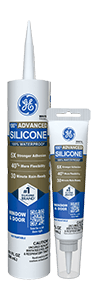Note: This DIY article is provided as a general guide only and is not intended to take the place of product-specific installation procedures; always follow applicable manufacturers’ instructions. Depending on your home’s age and condition, location within the home, and other potential factors, repairs and/or upgrades or other services may be necessary prior to the beginning and/or completion of your project that may involve the services of a home improvement professional. This article does not include advice pertaining to local building codes and/or any related inspections.
Choosing the right sealant for your home improvement project is crucial if you want both durability and a professional finish. Acrylic caulk and silicone are widely used sealants, each with unique properties that make them suitable for different applications. This blog will help you understand the strengths and limitations of acrylic caulk and silicone sealant and will help you decide which product to use for specific tasks.
Whether you’re sealing gaps in your bathroom or finishing interior trim, selecting the appropriate sealant can make a significant difference in the longevity and appearance of your work. By the end of this guide, you’ll be equipped with the knowledge to make an informed decision and finish your project with outstanding results.
Best uses for acrylic caulk
Acrylic caulk is a versatile sealant commonly used for interior finishing tasks. It’s particularly effective in projects where aesthetics and ease of application are important. For example, acrylic caulk is ideal for sealing gaps. Common areas of application include:
- Baseboards
- Crown molding
- Window and door frames
Acrylic caulks, like GE sealants’ Siliconized Multi-Purpose Acrylic Kitchen & Bath Caulk, create a smooth, paintable surface, making it an excellent choice for areas that require a neat, finished look.
In addition to its ease of application, acrylic caulk is flexible enough to handle minor shifts and movements in the materials it seals, preventing cracks and gaps from forming over time. This makes it a great choice for projects where slight movement is expected, such as in trim work and around fixtures. Undried caulk is also water-soluble and does not require harsh solvents for cleanup.
However, caulk has its limitations. It doesn’t work well in areas exposed to high moisture or extreme temperatures, as it can denature and lose its effectiveness. For these types of projects, a more durable sealant, like silicone, may be necessary.
You can use silicone sealant for windows, doors, and other exterior gaps to prevent drafts and water infiltration. Silicone’s persistent flexibility allows it to expand and contract — an absolutely necessary property for sealing older, wooden houses — with changing temperatures without cracking or losing adhesion.
Best uses for silicone sealant
Silicone sealant is a highly durable and flexible material, making it ideal for a variety of projects. Specifically, silicone sealant excels for applications in areas exposed to moisture and extreme temperatures. Its waterproof properties are particularly beneficial in areas such as bathrooms and kitchens, where builders frequently use it to seal around sinks, bathtubs, showers, and other fixtures regularly exposed to moisture.
Silicone sealant’s other useful characteristics include:
-
Durability and mold resistance:
Longevity and resistance to mold and mildew growth also make silicone sealant a superior choice for these environments.
-
Persistent elasticity
Silicone sealant remains elastic and intact in both high and low temperatures. Once in place, silicone seals will continue to adhere where they are applied, even under stress and structural movement. We recommend Advanced Silicone 2® Window & Door Sealant for high-stress areas.
-
Adhesion to non-porous materials:
Silicone sealant also bonds well with a variety of non-porous materials, including glass, metal, and ceramic. This makes it a preferred choice for sealing glass structures and other specialized applications where a strong, water-tight bond is required.
-
UV resistance:
Silicone sealant is resistant to ultraviolet light, making it suitable for outdoor applications where it won’t degrade from sun exposure.
You can use silicone sealant to seal windows, doors, and other exterior gaps to prevent drafts and water infiltration. Silicone’s persistent flexibility allows it to expand and contract — a necessary property for sealing older, wooden houses — with changing temperatures without cracking or losing adhesion.
Despite its advantages, silicone sealant does have some drawbacks in certain applications. In projects where a seamless, painted finish is desired it can be a limitation because it is not paintable. Additionally, silicone sealant can be more challenging to apply neatly and has a longer curing time than acrylic caulk. The cost is also higher, which might be a consideration for larger projects.
Silicone sealant, overall, is a reliable choice for high durability and water resistance areas, making it a valuable tool for residential and commercial projects.
Acrylic caulk vs. silicone sealant: how to choose
Selecting the right sealant depends on the specific needs of your project. For indoor projects requiring paintable surfaces, such as sealing gaps around baseboards or trim, acrylic caulk is the preferred choice due to its ease of application and clean-up with water.
Conversely, silicone sealant is superior for areas exposed to moisture and extreme temperatures, like bathrooms, kitchens, and outdoor applications. Its flexibility and durability make it ideal for sealing around sinks, bathtubs, and windows.
Additionally, consider the surfaces involved. Silicone adheres well to non-porous materials like glass and metal, while acrylic caulk is better for porous surfaces like wood. For larger projects where cost is a concern, caulk may be more economical. Ultimately, before you make a decision, assess:
- The environment
- Material compatibility
- Required longevity
Keeping these factors in mind, you can select the right materials to finish your project with professional style and quality.
Consider GE sealants for reliable sealing solutions in your next project. With a range of acrylic caulk and silicone products, you can find the perfect sealant to meet your specific needs. Ensure durability and professional results by choosing GE Sealants for your home improvement tasks.
To get GE sealants’ products for your home improvement project, visit these fine retailers.

